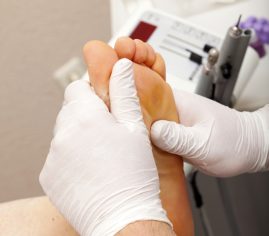Nail Surgery
Nail surgery is a procedure carried out under local anaesthetic to remove part of a nail or the whole nail. Problem nails can be ingrown nails or curved or thick nails that are causing pain.
Partial nail avulsion and Total nail avulsion are minor surgical procedures used to treat ingrown nails.
Nail surgery is carried out using a local anaesthetic injected into both sides of the base of the toe. When the toe is completely numb, a tourniquet is applied to minimise bleeding and a section of the nail or the whole nail is removed. A chemical called phenol is then applied to the area where the nail has been removed. This prevents the nail growing back. The appointment usually takes about 45-60minutes.
Frequently Asked Questions
What are the benefits of having nail surgery?
Permanent removal of a section of nail often cures the problem, although there is a small risk of re-growth. This procedure has a success rate of 95% or higher.
Will it hurt?
You may feel the initial injection but this only takes a few seconds to administer. For younger children a special cream can be used on the skin prior to using the anaesthetic, which can minimize discomfort. Once the anaesthetic starts to work the toe will be numb and the procedure is pain free. The podiatrist will not start the nail surgery until you are happy to continue.
What happens after the toe is numb?
Once the toe is numb a tourniquet is applied to stop any bleeding. The section of nail or the whole nail is gently removed and a liquid called phenol is applied to prevent the nail growing back. The tourniquet is removed and a dressing is applied.
How long does the nail surgery take?
The actual procedure only takes 20 minutes but the appointment is usually around 45-60 minutes. This includes time for paperwork, time for the anaesthetic to work and to complete the surgery.
Will I be able to walk afterwards?
For the first day you will need to wear sandals because the dressing is bulky. After that you can wear any shoes that are comfortable and will not put pressure on the toe. You are also advised to rest after the procedure to avoid any pressure or injury to the toe
Are there any risks?
As with any surgical procedure there are risks involved. Local anaesthetics are quite safe however there can be rare complications such as an allergic reaction. Every effort is made to reduce any complications. Please inform the podiatrist of any previous reactions or complications with local anaesthetics.

